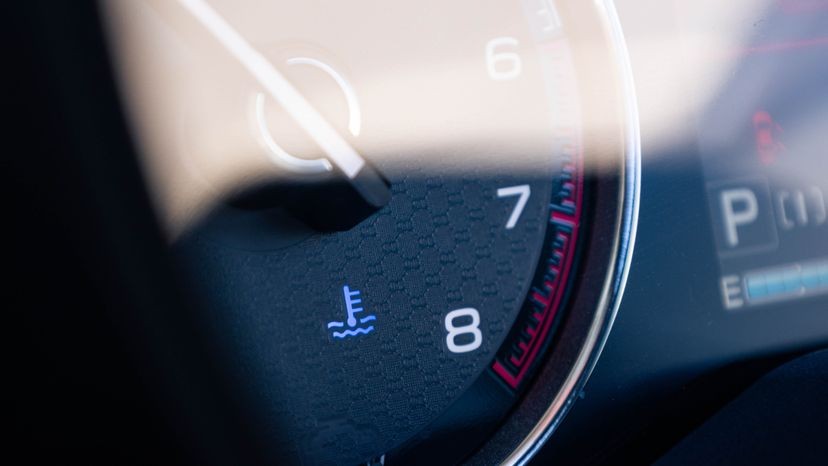In the intricate world of automotive engineering, every component plays a crucial role in a vehicle’s overall performance and longevity. For those wondering, “What Does The Thermostat Do In A Car?” the answer might reveal the surprisingly significant impact of this small device.
Designed to precisely regulate and maintain the engine’s optimal operating temperature, a car thermostat, typically around 2 inches (5 cm) in diameter, is a small part with a big job. It is essential in preventing your engine from overheating or running too cold, both of which can lead to serious problems.
How a Thermostat Works
Every car engine that uses liquid cooling includes a thermostat. This device is positioned in the cooling system, usually between the engine and the radiator. It functions as a temperature-sensitive valve to manage the flow of coolant. The thermostat is designed to automatically open and close based on specific temperature thresholds.
When you first start your car, and the engine is cold, the thermostat remains closed. This crucial action blocks coolant from flowing to the radiator. By restricting coolant circulation, the thermostat allows the engine to warm up rapidly to its ideal operating temperature.
Once the engine reaches its designated operating temperature—generally around 200 degrees Fahrenheit (95 degrees Celsius)—the thermostat begins to open. This opening action allows coolant to flow to the radiator. The radiator then dissipates heat from the coolant, effectively cooling it before it returns to the engine. This continuous cycle prevents the engine from overheating and maintains a stable temperature.
 Close up of a car engine thermostat, highlighting its small size and location in the cooling system.
Close up of a car engine thermostat, highlighting its small size and location in the cooling system.
The secret behind a thermostat’s operation lies in a small cylinder, typically found on the engine side of the unit. This cylinder is filled with a specialized wax that is engineered to melt at a specific temperature, often around 180 degrees Fahrenheit (82 degrees Celsius), though this temperature can vary depending on the vehicle and thermostat design.
A rod, connected to the thermostat valve, is in contact with this wax. When the engine temperature rises and the wax reaches its melting point, it undergoes a phase transition from solid to liquid. This phase change causes a significant expansion in the wax volume. The expanding wax exerts pressure on the rod, pushing it out of the cylinder. This mechanical action opens the thermostat valve, initiating coolant flow to the radiator and starting the engine cooling process.
Why a Thermostat is Important
A properly functioning thermostat is vital for several key reasons that impact engine performance, efficiency, and longevity:
- Enhanced Engine Performance: By ensuring the engine operates at its optimal temperature, the thermostat is a key component in maintaining engine efficiency. Engines designed to run at specific temperatures perform best within that range. A thermostat ensures the engine reaches and stays within this ideal zone, leading to smoother and more responsive performance.
- Reduced Emissions: Engines that run at their correct operating temperature produce fewer harmful emissions. Efficient combustion, achieved through proper temperature regulation, minimizes the release of pollutants. The thermostat contributes to cleaner emissions by helping the engine achieve and maintain this efficient combustion temperature.
- Overheating Prevention: Engine overheating is a major cause of engine damage. A malfunctioning thermostat, particularly one stuck closed, can lead to rapid overheating. By properly regulating coolant flow, the thermostat actively prevents overheating, safeguarding critical engine components from heat-related damage like warped cylinder heads or blown head gaskets.
- Extended Engine Life: Consistent operation at optimal temperatures reduces stress and wear on engine components. By preventing extreme temperature fluctuations, the thermostat plays a role in prolonging the lifespan of the engine and its related parts. This can translate to significant savings on potential repairs and replacements over the vehicle’s life.
Symptoms of a Faulty Thermostat
When a thermostat malfunctions, it can lead to a range of engine temperature issues, manifesting as overheating, underheating, or erratic temperature swings. Recognizing the symptoms of a failing thermostat is crucial for timely maintenance and preventing more severe engine problems. Here are some common signs to watch for:
- Engine Overheating: Perhaps the most critical symptom, engine overheating often points to a thermostat stuck in the closed position. When closed, it blocks coolant flow to the radiator. Without cooling, the engine temperature can climb rapidly, potentially causing severe damage such as cylinder head warping, head gasket failure, or even complete engine failure in extreme cases.
- Engine Running Too Cold: Conversely, a thermostat stuck in the open position allows coolant to constantly circulate to the radiator, even when the engine is cold. This overcooling prevents the engine from reaching its minimum operating temperature. An engine that runs too cold is inefficient, leading to reduced fuel economy, increased engine wear, and potentially poor heater performance in the cabin.
- Fluctuating Engine Temperatures: Inconsistent temperature gauge readings, with the temperature moving up and down erratically, can indicate a thermostat that is opening and closing irregularly or sticking intermittently. These fluctuations can disrupt the engine’s computer controls, leading to reduced engine performance, decreased fuel efficiency, and increased emissions.
- Unusual Temperature Gauge Readings: Keep an eye on your car’s temperature gauge. It is often the first indicator of a thermostat problem. Readings that are consistently higher or lower than normal, or sudden and significant fluctuations, should prompt an inspection of the thermostat and the entire cooling system.
- Increased Fuel Consumption: If your vehicle starts consuming more fuel than usual, a malfunctioning thermostat could be a contributing factor. When the engine doesn’t reach its optimal temperature, it operates less efficiently. To compensate, the engine control system may enrich the fuel mixture, leading to increased fuel consumption.
If you observe any of these symptoms, it’s important to have your vehicle inspected by a qualified mechanic. Prompt diagnosis and replacement of a faulty thermostat can prevent significant engine damage and ensure continued reliable vehicle operation.
Engine Temperature Basics
Despite its small size, the thermostat remains a vital and indispensable component within modern automotive cooling systems. Its role in regulating engine temperature is fundamental to ensuring optimal engine performance, minimizing harmful emissions, and preventing costly engine damage.
Regular vehicle maintenance should include checks of the cooling system, and timely replacement of a faulty car thermostat is a proactive step every car owner can take to maintain their vehicle’s health, efficiency, and longevity.
Car Thermostat FAQs
What are the telltale signs of a failing thermostat?
Common signs include consistently high temperature readings on the gauge, engine overheating, coolant leaks around the thermostat housing, and erratic or fluctuating temperature readings.
What should I expect to pay to replace my car thermostat?
The average cost to replace a car thermostat, including parts and labor by a professional mechanic, typically ranges from $140 to $300. However, this cost can vary depending on the make and model of your vehicle and local labor rates.
What will happen if I drive my car without a thermostat?
Driving without a thermostat is not recommended. Without a thermostat, the engine will struggle to reach its optimal operating temperature, especially in cold weather. This can lead to reduced fuel efficiency, increased engine wear, and potentially poor heater performance. In some cases, it could also contribute to overheating if the cooling system cannot regulate temperature effectively without the thermostat’s control.
